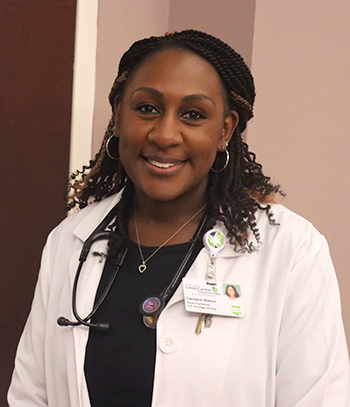What is benign breast disease?
Women's Care
Telfair Breast Surgery nurse practitioner explains these common, non-cancerous conditions women, and men, may develop in their breasts
If you feel a lump during a self-breast exam or get a call that something was spotted on your latest mammogram, your first thought may be, ‘It’s cancer.’
Yes, breast cancer is one of the leading cancer diagnoses in women. But there’s no need for immediate panic. You could have a benign breast condition that is not life-threatening and is not cancer.
Generally speaking, benign breast disease is a group of conditions that involve breast changes that are not malignant. These changes can be found on imaging, felt during self-breast exams or discovered following breast discomfort.

Benign breast disease is very common. In fact, the team at Telfair Breast Surgery at St. Joseph’s/Candler sees more benign breast conditions than cancer, says Candace Walton, nurse practitioner at Telfair Breast Surgery.
“Normally, it starts with imaging, Sometimes it does start with generalized breast pain or they feel a mass,” Walton says. “A lot of patients may have their first mammogram that shows something in their breast that’s been there for a long time, and they just didn’t know it. It gets flagged, such as a cyst, but a large majority of them are benign cysts.”
Some of the more common conditions of benign breast disease include:
- Cysts: A fluid-filled sac in the breast tissue. Cysts are most common in those nearing menopause, but can develop at any age. They often get larger and become sore just before your cycle, and they may even seem to appear overnight. They can feel either hard or soft. Cysts are rarely cancer.
- Fibroadenoma: A solid, smooth, firm non-cancerous lump most often found in people in their 20s and 30s, but can occur at any age. Usually painless, these lumps feel rubbery and move around freely. Fibroadenomas vary in size and can grow anywhere in the breast tissue.
- Intraductal Papilloma: A small, wart-like growth that bumps out into the breast ducts near the nipple and may cause bloody or sticky discharge. Single papillomas most often affect people nearing menopause, but multiple ones are common in younger females. They also often happen in both breasts.
Our team at Telfair Breast Surgery also can help monitor or treat women with unusual breast cells that are not cancerous, women with dense breast tissue and patients with a history of breast cancer but don’t have the disease, Walton says.
Related Article: What does it mean if I have dense breasts?
Treating and monitoring these conditions
Some benign breast conditions can cause pain or discomfort and need treatment. Others do not need treatment. For example, women with unusual cells, dense breast tissue or a family history may just need supplemental screening and long-term monitoring.
Certain types of cysts and fibroadenomas will be monitored for up to two years, and if there’s no change and discomfort that requires removal, the patient will be discharged, Walton says. But, she adds that anytime a patient has symptoms that persist or feels something growing, she should come back for a checkup.
Depending on what type of cysts you have, they can be drained to alleviate pain. Some cysts can be removed. If it’s topical, or near the skin, a Telfair Breast Surgery surgeon can remove it right in the office.
Intraductal papillomas are almost always removed because they can hide cancerous cells. The papilloma itself is not cancerous but it can cause a hindrance during imaging, Walton says.
We can’t stress it enough
“Most benign issues have nothing to do with cancer or leading up to cancer,” Walton emphasizes.
Another thing we can’t stress enough: screening.
Your first line of defense to finding anything unusual with your breasts – whether benign or malignant – is mammography. Walton also points out to patients the importance of monthly self-breast exams. A lot of benign conditions start in younger ages, 20s and 30s, before recommended screening at 40.
“We tell women always, always, if you feel something, come in. Most of the time it is benign, but sometimes it’s not, and it’s better to know than not to know,” Walton says. “If you feel anything abnormal or if any imaging calls for you to come back in for additional imaging or biopsy, we encourage women to please follow up on those things.”